Collection, storage and growth of the 9580* habitat characteristic species
04-12-2019
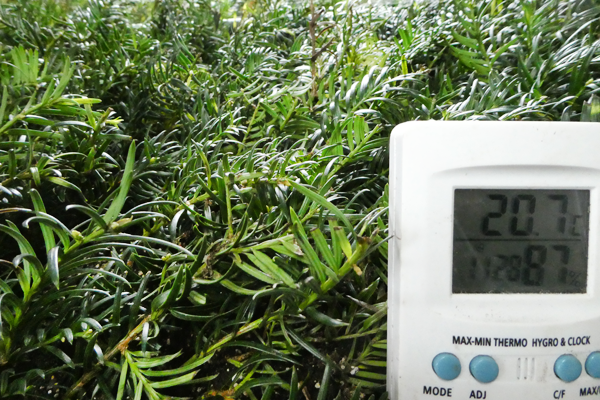
The LIFE BACCATA Project seeks to improve the habitat 9580* conservation status in 15 SCAs (Special Conservation Areas) found in the Cantabrian Mountain Range by acting upon indicators of the conservation status: Area of occupancy, structure and functions and future prospects. In Galicia, the Project is focused on 15 ha located at the ‛Monte Vecinal en Mano Común’ (communal woodlands Known by the Spanish acronym MVMC) of Riocereixa (Pedrafita do Cebreiro, Lugo), within the Os Ancares – O Courel SCA (ES1120001). This area will be subject to the removal of a reforesting pine grove (Action C2) and the habitat 9580* type will be restored with a forestry plantation made up of characteristic species (Action C3). To this end, those conditions affecting the habitat type will be eliminated, its current area of occupancy will be increased and its structure, composition and connectedness will be improved, all together will contribute to improve its conservation status.
In planting habitat 9580* forestry species, and bearing in mind it is a Natura 2000 designated site, it was required to use forestry reproductive material (FRM) compatible with the local genetic pool. To ensure that compatibility, it was considered in the framework of the Project to use FRM from the Riocereixa MVMC itself. For this action, twigs and seeds from the 9580* habitat tree characteristic species were collected from the said MVMC. It was carried out according to the Galician Habitat Manual (Taxus baccata, Quercus petraea, Fagus sylvatica, Betula pubescens, Sorbus aucuparia, Ilex aquifolium, Corylus avellana) and then this material was stored, conserved and grown (Action C1). IBADER, from the University of Santiago de Compostela, implemented this Action, relying on some external support during some phases where necessary.
Phase 1 COLLECTING PLANT MATERIAL
This phase took place in 2017 and 2018 and consisted of the gathering of FMR from habitat 9580* characteristic species according to the Galician Habitat Manual (Taxus baccata, Quercus petraea, Fagus sylvatica, Betula pubescens, Sorbus aucuparia, Ilex aquifolium, Corylus avellana). To reckon the necessary amount of plant, the overall area for reforestation and ratios of dominant and companion species of this type of habitat according to the Galician Habitat Manual were taken into account. The time schedule for the collection work was established out of critical periods for the species of conservation interest whose habitat is located within the FMR collection areas.
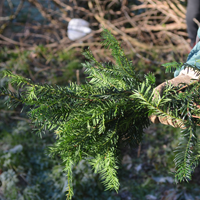 During the first year (2017), seeds from any characteristic species of 9580* habitat were collected since the use of sexually reproduced material allows us to ensure the genetic diversity of reforestations. This task was completed according to the following determining factors:
During the first year (2017), seeds from any characteristic species of 9580* habitat were collected since the use of sexually reproduced material allows us to ensure the genetic diversity of reforestations. This task was completed according to the following determining factors:
In planting habitat 9580* forestry species, and bearing in mind it is a Natura 2000 designated site, it was required to use forestry reproductive material (FRM) compatible with the local genetic pool. To ensure that compatibility, it was considered in the framework of the Project to use FRM from the Riocereixa MVMC itself. For this action, twigs and seeds from the 9580* habitat tree characteristic species were collected from the said MVMC. It was carried out according to the Galician Habitat Manual (Taxus baccata, Quercus petraea, Fagus sylvatica, Betula pubescens, Sorbus aucuparia, Ilex aquifolium, Corylus avellana) and then this material was stored, conserved and grown (Action C1). IBADER, from the University of Santiago de Compostela, implemented this Action, relying on some external support during some phases where necessary.
Phase 1 COLLECTING PLANT MATERIAL
This phase took place in 2017 and 2018 and consisted of the gathering of FMR from habitat 9580* characteristic species according to the Galician Habitat Manual (Taxus baccata, Quercus petraea, Fagus sylvatica, Betula pubescens, Sorbus aucuparia, Ilex aquifolium, Corylus avellana). To reckon the necessary amount of plant, the overall area for reforestation and ratios of dominant and companion species of this type of habitat according to the Galician Habitat Manual were taken into account. The time schedule for the collection work was established out of critical periods for the species of conservation interest whose habitat is located within the FMR collection areas.
 During the first year (2017), seeds from any characteristic species of 9580* habitat were collected since the use of sexually reproduced material allows us to ensure the genetic diversity of reforestations. This task was completed according to the following determining factors:
During the first year (2017), seeds from any characteristic species of 9580* habitat were collected since the use of sexually reproduced material allows us to ensure the genetic diversity of reforestations. This task was completed according to the following determining factors: - - Collection work was manually carried out in the day time.
- - No mechanical means were used.
- - Seed donating feet were not shaken.
- - Seed was collected from the forest floor or by accessing it with a ladder.
- - Only seeds that morphologically seemed to be viable in the future were collected.
- - Seed donating feet were not damaged during the collecting process and the seeds collected came from a suitable number of specimens as compared to the total available tree feet, which means that the recruitment ability of these species natural populations were not affected.
- - To collect the appropriate amount of seeds per specimen, 30% of the available seeds was left on each foot to avoid an impact on the dispersal of seeds by birds.
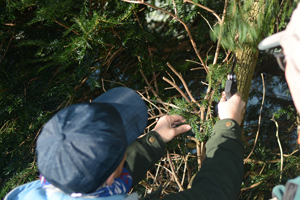
Thanks to this, it was possible to collect an adequate number of seeds from the entire habitat 9580* characteristic species, except for their own dominant species, that is, Taxus baccata. The late frost events in April of 2017 damaged the feminine flowers of local yew trees which resulted in the low production of seeds during the summer of 2017. This was not enough to meet the objectives set by the LIFE BACCATA in terms of plant production.
However this type of unexpected situations were already taken into account for the project so, during the winter and fall of 2018, the Riocereixa MCMC was visited in different occasions with the aim to collect FMR to produce Taxus baccata cuttings. This action will allow us to produce an adequate amount of plants to provide the target plantation figures set for the Project and therefore the successful reforestation (Action C3). To this end, a team made up of 2-4 persons went to Riocereixa MVMC and they were able, by using the appropriate tools (secateurs, trimmer, poles, rope for tying, bags, markers, etc.) to collect the Taxus baccata rods. The inhabitants and owners of the Riocereixa MVMC took charge of choosing the collection sites and feet. They also monitored the actions and gave advice all times as they were especially interested in the success and long-term maintenance of the reforestation the LIFE BACATTA PROJECT will carry out in their property. In this regard, they reported to IBADER team about the best feet for the intended objective as these inhabitants are the best judges of any essential aspect regarding their forests.
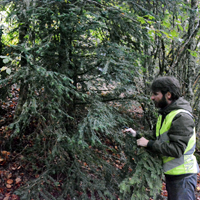 To promote diversity as much as possible, collection work was done on over 50 yew specimens ensuring that the samples collected were both, feminine and masculine and in similar proportions. At any rate, to boost the success of the final outcomes, the material is collected from those branches previously selected, according to the type of cuttings that is to be produced and by complying with the following protocol
To promote diversity as much as possible, collection work was done on over 50 yew specimens ensuring that the samples collected were both, feminine and masculine and in similar proportions. At any rate, to boost the success of the final outcomes, the material is collected from those branches previously selected, according to the type of cuttings that is to be produced and by complying with the following protocol- Rods with 2-3 internodes were collected
- The rod baseline diameter is less than 10 mm.
- Branches with Taxomya taxi galls were avoided as much as possible.
- Rods were cut with sterile and well-sharpened material, applying clean cuts, without any tearing or roughness. In the process tree structure was not damaged and its biomechanics was not affected either.
- The material is prepared with rope ties that allow a convenient storage in sealed plastic bags to prevent any damage to rods.
- Transport of bags filled with FRM to the nursing was carefully done, by placing the bags in the vehicle in such as way and spots that the material could not be damaged and to avoid the direct sun rays. Furthermore, the vehicle was never parked in the sun when the material bags were inside and this way plants were not negatively affected by high temperatures.
 Once the Taxus baccata rod-based FRM was collected and selected, it was transported to the nursing to be grown, fattened and used later on in the 9580* habitat plantations.
Once the Taxus baccata rod-based FRM was collected and selected, it was transported to the nursing to be grown, fattened and used later on in the 9580* habitat plantations.Phase 2. FOREST PLANT GROWTH AND FATTENING UP.
Once plants collected during Phase 1 reach the nursing, storage and preparation work begins so that plants are grown and fattened up. In the case of seeds-originated species, they were first grown in 2017 and it was relatively simple. They were grown in seedbed and sown in trays so that germination took place orderly and under control (with shade netting or nursing netting, vermiculite and agri-pearlite substrate, controlled irrigation and humidity content, etc.), in order to grow effortlessly until the plant is ready to be used in the reforestation.
Concerning Taxus baccata, it reached the nursing in the shape of rods in February of 2018, after a first accession. Then in October of 2018, during the second time collection was done, it was used to produce cuttings and to provide plants in different phenological stages and also to compare outcomes and successful proportions. In both case and after being delivered to the nursing, this plant was stored in a cool room at 3º y 5 ºC. Subsequently it was prepared as cuttings and transplanted to trays.
The first step in preparing the material was to select the best one because, despite the transportation of the material complied with the required conditions, a detailed review of the material can be done in the nursery. In this process, damaged branches or those not complying with the required conditions according to the type of cuttings to be produced can be discarded.
Secondly, material was trimmed in the shape of cuttings to fit in the forestry container. Hence each rod has 2-3 internodes, approximately 6-10 cuttings can be produced per each rod according to the following types:
Apical cuttings of approximately 15/20 cm long with a diameter of up to 5 mm and preferably lignified base.
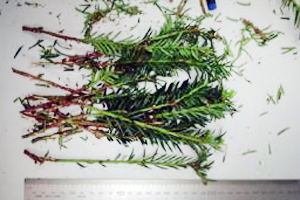
Heel cuttings of secondary branches with small branches of approximately 5/10 cm long (most of the produced ones).
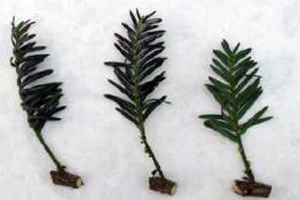
Leaves are stripped from every cutting in the cutting’s growth direction to trigger the generation of callosity. Additionally, some lateral scrapping was done to increase the cambium accessible area. Then each plant is sunken in rooting liquid hormone for 20 seconds and then inserted in a forest container with a mixture of substrate and agri-perlite which was previously hollowed out to accommodate the plant. Once this step is completed, trays were placed on the table with some background heat (15/20ºC) and a controlled temperature (10/15ºC) until the first plant rooting started to be at sight, months later. At this time they were transplanted to the container with commercial substrate based on a charcoal mixture.
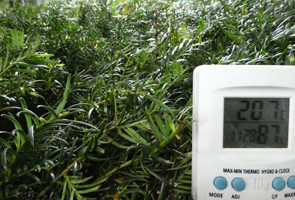
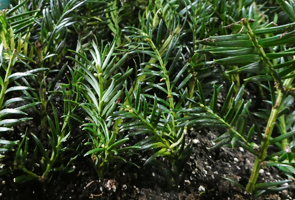
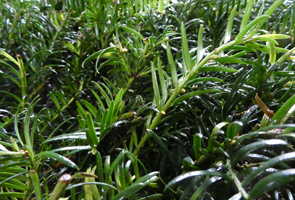
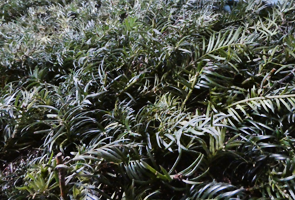
The whole process, that started in 2017, for seed-originated reforestation plants, and in the winter of 2018, for cutting-originated plants, and ended in the spring of 2019, allowed the production of forestry plants with a sufficient quality and quantity to ensure the reforestation of the 15 ha located in the Riocereixa MVMC that are the object of this Project. The production figures per plant species that are available for LIFE BACCATA in their Galician locality are as follows:
| Taxus baccata | > 4.000 plants |
| Betula pubescens | > 3.000 plants |
| Fagus sylvatica | > 2.000 plants |
| Quercus petraea | > 2.000 plants |
| Sorbus aucuparia | > 1.000 plants |
| Ilex aquifolium | > 1.000 plants |
| Corylus avellana | > 200 plants |
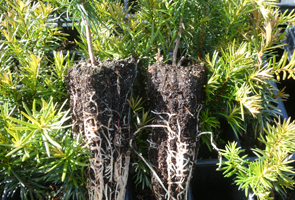
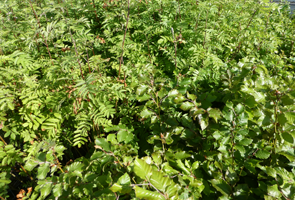
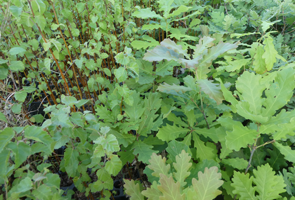

The plant produced is suitable for reforestation use hence it is in forestry containers, has an adequate height and diameter and their root development is significant, without rolling up too much because the container has been sufficiently spacy as to allow a trouble-free root growth.



